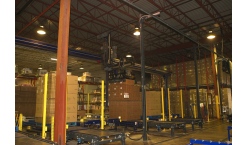
Ripple Effect
By Andrew Joseph, Features Editor
Automation Wulftec/M.J. Maillis Group Yum Yum Potato Chips
Based on the multitude of things you can do with it in a modern kitchen, the humble potato is arguably one of Mother Nature’s most undersung miracles in terms of solid nourishment, culinary variety and ‘good-for-you’ nutritional value.
And for the more entrepreneurial types among us, it can be pretty good for the pocketbook to boot.
In 1959, a local businessman named Paul Jalbert and a partner purchased (Croustilles) Yum Yum Potato Chips—at that time a small three-year-old snack-food shop in Warwick, Que., struggling to overcome the limitations of some badly outdated machinery with strict attention to product quality and a handful of valuable recipes for cooking up great-tasting potato chips with remarkably crisp texture.
“With a name like ‘Yum Yum’ the company really had to ensure that it would only sell the best-tasting chips they could make—rejecting those that didn’t quite make the grade,” explains Yum Yum’s plant manager Jacques Breton.
“It was ultimately because of this sterling reputation for high quality, and great taste, that the company began to achieve success.”
It also helped that by 1953 Jalbert had amassed enough capital from his Canadian importing and distribution rights for the packaged peanuts produced at the time by Krispy Kernels of Newark, N.J., to purchase the business outright—eventually combining it with Yum Yum inside a shared 9,000-square-foot production and warehousing facility.
The combination proved to be a winning recipe all around, as by 1984 the company was employing some 240 people at a modern, 100,000-square-foot plant that was already running out of space to accommodate the growing volumes.
“Business was booming so much that the volume of potatoes processed increased one hundredfold,” Breton told Canadian Packaging in a recent interview, prompting Yum Yum to build an additional 25,000-square-foot facility dedicated solely for potato storage in 1986.
The following year, Yum Yum spent over $5 million to enlarge the space devoted to finished product—extending the plant by an additional 55,000 square feet—and to acquire more modern machinery to speed up the packaging process.
The upgrade also entailed installation of new inspection equipment for quality assurance of the finished product, Breton recounts, and an expansive conveyance system to transfer finished product to the packaging and shipping areas of the plant.
In 1989, Jalbert’s son Denis became the sole owner of the company and quickly set about modernizing the plant further to ensure its long-term competitiveness.
“We purchased an automated packaging and labeling system in the 1990s, which helped us better manage our product inventory and quality,” states Breton.
Advertisement

